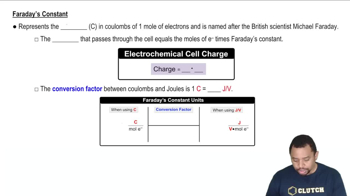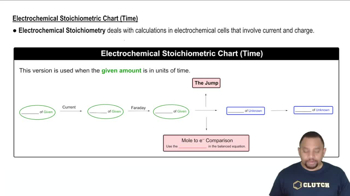Here are the essential concepts you must grasp in order to answer the question correctly.
Electrolysis
Electrolysis is a chemical process that uses electrical energy to drive a non-spontaneous reaction. In the case of molten MgCl2, applying a current causes magnesium ions to migrate to the cathode, where they gain electrons and are reduced to form metallic magnesium. Understanding the principles of electrolysis is essential for calculating the mass of magnesium produced and the time required for the reaction.
Recommended video:
Faraday's Laws of Electrolysis
Faraday's Laws of Electrolysis quantify the relationship between the amount of substance produced at an electrode and the quantity of electric charge passed through the electrolyte. The first law states that the mass of a substance altered at an electrode is directly proportional to the total electric charge passed. This principle is crucial for determining the mass of magnesium formed and the time needed for electrolysis.
Recommended video:
Faraday's Constant in Electrochemistry
Current and Time Relationship
The relationship between current, time, and charge is fundamental in electrolysis calculations. The total charge (Q) can be calculated using the formula Q = I × t, where I is the current in amperes and t is the time in seconds. This relationship allows for the conversion of current and time into the total charge, which is necessary for applying Faraday's laws to find the mass of magnesium produced or the time required for a specific mass.
Recommended video:
Electrochemical Stoichiometric Chart (Time)
 Verified step by step guidance
Verified step by step guidance

